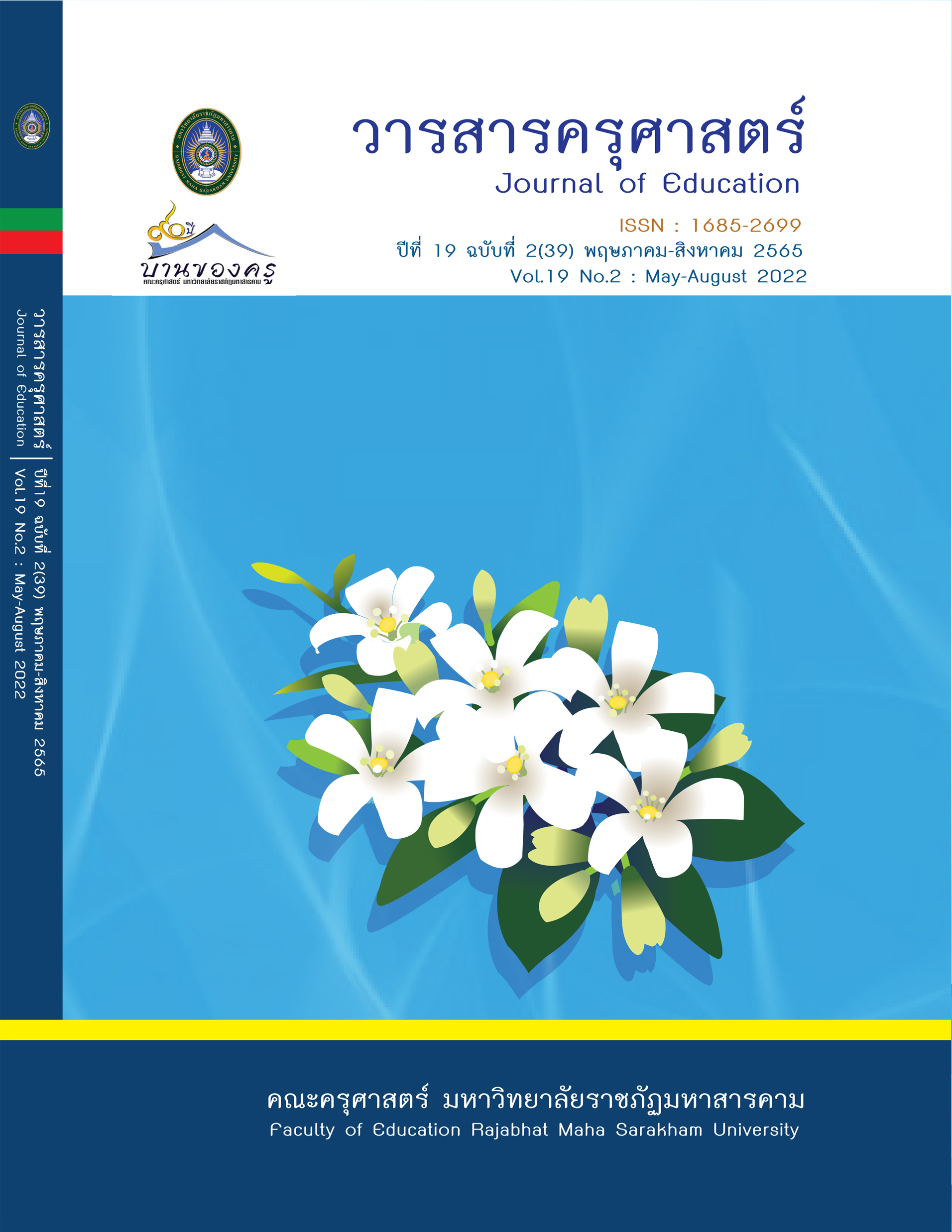The Promotion of Thai Dramatic Arts Practical Skill by Harrow's Blended Learning for Grade 6 Students, Saithong Chalermwit School
Main Article Content
Abstract
The purposes of this research were to 1) study the promotion of Thai dramatics art practical skill by Harrow's blended learning for grade 6 students, Saithong Chalermwit school, and 2) study the samples’ satisfaction toward the learning model. The sample consisted of grade 6 students, Saithong Chalermwit school. The research tools used 2 lesson plans, a practical skill assessment form, a journal writing form, and satisfaction form. The statistics were mean and standard deviation.
The research found as follows. 1) The promotion of Thai dancing's action skill by Harrow's blended learning in the second cycle of this activity was at good level which 4.07 mean score. It showed that the model was efficiency for learning activity management. Since the teacher used the problem reflections from the first cycle, adapted them, and used in the second cycle. This guided the students to have more learning skill, and had mutual understand the content of the course. Moreover, the various appropriate learning activities were provided; the students motivating, group discussion, counseling and guidance, thinking skill training, using skills for learning and creating the dance forms, practicing, repetition until they had their own dance skill, and solve their problems themselves by exchanging opinion and group planning together. These motivated the students to learn the lessons, and responded their assignments, 2) the students satisfied the learning model at the highest level which 4.54 mean score.
Article Details

This work is licensed under a Creative Commons Attribution-NonCommercial-NoDerivatives 4.0 International License.
ข้อกำหนดเบื้องต้นที่ผู้นิพนธ์(ผู้ส่งบทความ) ควรทราบ
1. ผู้นิพนธ์ที่ประสงค์จะลงตีพิมพ์บทความกับวารสาร ตั้งแต่เดือนมกราคม 2563 เป็นต้นไป ให้ใช้รูปแบบใหม่ (Template 2563) โดยสามารถดูตัวอย่างได้ที่เมนู GUIDELINES
2. จะตีพิมพ์และเผยแพร่ได้ ต้องผ่านการประเมินจากผู้ทรงคุณวุฒิ (Peer Review)
3. การประเมินบทความโดยผู้ทรงคุณวุฒิ (Peer Review) เป็นแบบ Double Blind
4. การอ้างอิงบทความใช้หลักเกณฑ์ APA (American Psychological Association) คลิก
5. บทความถูกปฏิเสธการตีพิมพ์ ไม่ผ่านการประเมิน ผู้นิพนธ์ขอยกเลิกเองหรือชำระเงินก่อนได้รับการอนุมัติ ทางวารสารไม่มีนโยบายการคืนเงิน
References
กรมวิชาการ กระทรวงศึกษาธิการ. (2544). หลักสูตรการศึกษาขั้นพื้นฐาน. สำนักพิมพ์พัฒนาคุณภาพวิชาการพว.
กรมวิชาการ กระทรวงศึกษาธิการ. (2545). หลักสูตรการศึกษาขั้นพื้นฐาน พุทธศักราช 2545. สำนักพิมพ์พัฒนา
คุณภาพวิชาการพว.
กาญจนา อินทรสุนานนท์ และ รุจี ศรีสมบัติ. (2552). รําวงมาตรฐาน. สำนักพิมพ์ไทยวัฒนพานิช.
ดุษฎี มีป้อม และ นิลวรรณ ถมังรักษ์สัตว์. (2559). หนังสือเรียนรายวิชา ดนตรี-นาฏศิลป์
ชั้นมัธยมศึกษาปีที่ 3. สำนักพิมพ์วัฒนาพานิช.
ทิศนา แขมมณี. (2556).รูปแบบการเรียนการสอนทางเลือกที่หลากหลาย (พิมพ์ครั้งที่8).
สำนักพิมพ์แห่งจุฬาลงกรณ์มหาวิทยาลัย.
ปกรณ์ รัตนทำ. (2561). การพัฒนากิจกรรมการเรียนรู้ผสมผสานตามรูปแบบซิปปาที่
ส่งเสริมความคิดสร้างสรรค์ สำหรับนักศึกษาปริญญาตรี. {วิทยานิพนธ์ปริญญามหาบัณฑิต ไม่ได้ตีพิมพ์}. มหาวิทยาลัยราชภัฏมหาสารคาม.
รสสุคนธ์ เพ็ญเนตร. (2561). การพัฒนาทักษะปฏิบัตินาฏยศัพท์และภาษาท่าโดยใช้การเรียนรู้
แบบกลุ่มร่วมมือเทคนิค TAI ร่วมกับแนวคิดการสอนปฏิบัติของแฮร์โรว์ สำหรับนักเรียนชั้น ประถมศึกษาปีที่4. {วิทยานิพนธ์ปริญญามหาบัณฑิต ไม่ได้ตีพิมพ์}. มหาวิทยาลัยราชภัฏมหาสารคาม.
ศิวพงษ์ สาระรัตน์. (2559). การพัฒนาบทเรียนบนเว็บ โดยใช้เทคนิคการสอนหมวกหกใบร่วมกับ
สแคฟโฟลดิ้งที่ส่งเสริมทักษะปฏิบัติสำหรับนักเรียนชั้นมัธยมศึกษาตอนต้น.
{วิทยานิพนธ์ปริญญามหาบัณฑิต ไม่ได้ตีพิมพ์}. มหาวิทยาลัยราชภัฏมหาสารคาม.
Graham, C. R. (2004). Blended learning systems: Definition, current trends and future directions.
Feiffer.
Harrow, A. (1972). Ataxonomy of the psychomotor domain: A guide for developing behavioral
Objectives. Longman Inc.
Kemmis, S., & McTaggart, R. (1988). The Action Research Planner (3rd ed.) Deakin University Press


